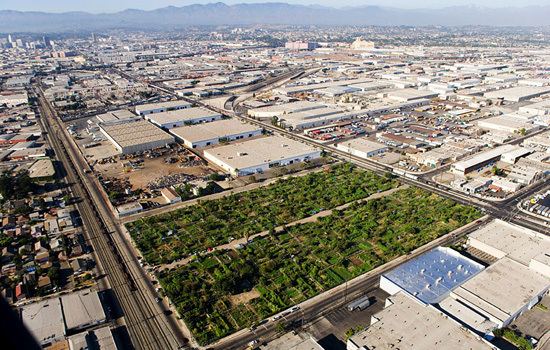 | ||
South central farm full length 24 min
The South Central Farm, also known as the South Central Community Garden, was an urban farm and community garden located at East 41st and South Alameda Streets, in an industrial area of South Los Angeles, California (known as South Central Los Angeles) which was in operation between 1994 and 2006. At 14 acres (5.7 ha), it was considered one of the largest urban farms in the United States. The farm was sold in 2004, and the farmers were evicted in 2006. On July 5, 2006, workers began bulldozing the farm amidst strong protest and acts of civil disobedience. The farmers disputed the validity of the sale in court and staged vigils in protest. The farm is the subject of the 2008 Academy Award-nominated documentary film, The Garden. It was also the subject of the PBS documentary, with an AFI Film Festival Premiere, in the Natural Heroes Series, South Central Farm, Oasis in a Concrete Desert. This documentary has the only first-hand commentary from the developer. As of May 2014 the land remains an empty lot.
Contents
- South central farm full length 24 min
- South central farm oasis in a concrete desert
- History
- Current status
- Plant life
- Farmers
- Criticism
- References
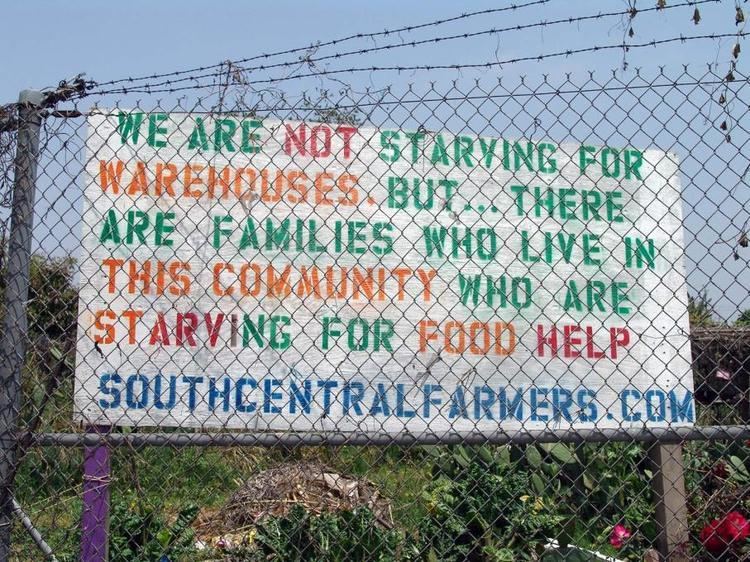
South central farm oasis in a concrete desert
History
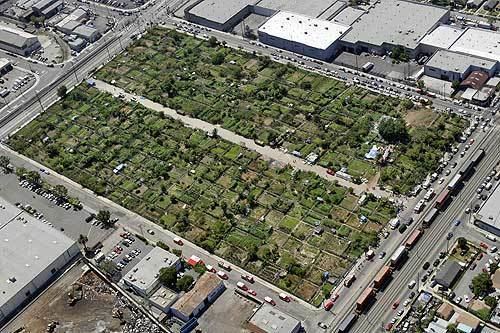
Before the creation of the garden, the land belonged to nine different owners, the largest of which was Alameda-Barbara Investment Company, a real-estate firm which purchased its share in 1980. The company held 80% of the property that would become the present urban garden. The City of Los Angeles acquired the land by eminent domain in 1986, for the purpose of building a waste-to-energy incinerator known as the Los Angeles City Energy Recovery Project (LANCER). This idea was abandoned because of community opposition, led by Concerned Citizens of South-Central Los Angeles. The city paid $4,786,372 for the property.

The final order of condemnation under eminent domain included a right to repurchase the land for the largest land owner, Alameda-Barbara Investment Company, should the city sell it for non-public or non-housing purposes within ten years of the condemnation. The City sold the property to the L.A. Harbor Department in 1994.
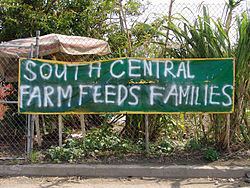
In July 1994 the Harbor Department granted a revocable permit to the L.A. Regional Food Bank – a private, nonprofit food-distribution network housed across the street from the Lancer incinerator site – to occupy and use the site as a community garden.
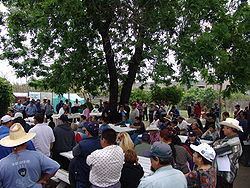
In 2001, Ralph Horowitz, a partner in the former property owner Alameda-Barbara sued the City for breach of contract, for failure to honor the original right of repurchase. The City denied his claim.
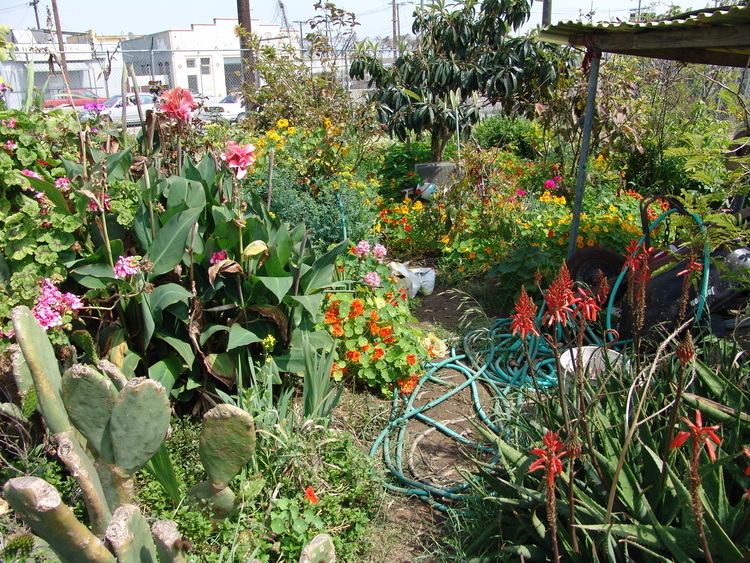
In 2003, the City of L.A. settled with Horowitz, in a closed-door session. The sale was for $5,050,000, slightly above the $4.8 million the City had paid for it in the eminent domain seizure. The settlement was done to comply with the repurchase clause as the court had mandated. Horowitz agreed to donate 2.6 acres (11,000 m2) of the site, valued at nearly $3,000,000, for a public soccer field, as part of the settlement. The City Council discussed and approved the terms of the settlement in closed session. The South Central Farm's lawyer, Patrick Dunlevy, claims that despite repeated requests, negotiation documents relating to the session have never been released.
Shortly thereafter the project was abandoned. In response the farmers formed an organization calling themselves the 'South Central Farmers Feeding Families'.
On January 8, 2004, Horowitz issued a notice to the gardeners setting February 29, 2004, as the termination date for the community garden. In response members of the South Central Farmers Feeding Families obtained legal counsel (Hadsell & Stormer, Inc., and Kaye, Mclane & Bednarski LLP) and filed a lawsuit seeking to invalidate the sale of the property. The Los Angeles County Superior Court issued a temporary restraining order and later a preliminary injunction halting development of the property until the lawsuit could be settled. The farmers lost the lawsuit and the court dissolved the injunction, freeing Horowitz to evict the farmers.
Initially, Horowitz sought $16.3 million for the property, more than three times the 1986 eminent domain valuation. In a deal brokered in cooperation by The Trust for Public Land, the SCF successfully raised a little over $6 million. Fundraising efforts continued as farmers and celebrities began both a tree-sitting campaign and occupation of the land, while under the threat of forced eviction by the Los Angeles County Sheriff's Department.
On June 7, 2006, the Annenberg Foundation announced that they would donate the money to buy the farm. Horowitz, however, did not respond to the offer, since it came after his May 22 deadline.
At 3 a.m. on the morning of June 13, 2006, the Los Angeles County Sheriff's Department arrived at the farm, fully surrounding it by 4 a.m. At 5 a.m., the sheriffs entered the farm, giving the occupants 15 minutes to evacuate. At that point, most of the occupants of the land left, with a few verbal skirmishes reported. According to the Los Angeles Times, more than 40 protesters were arrested. Actress Daryl Hannah was removed from the walnut tree in which she and another tree-sitter had been protesting the eviction and was arrested.
In June 2006 the farm was protected by a private security company hired by Horowitz to prevent members of the South Central Farm returning to squat on the land. Horowitz told the Los Angeles Times and KFI that he would not sell the land to them even if they offered him $100 million, because of the picketing of his house and anti-Semitic remarks directed towards him.
On July 5, 2006, workers began bulldozing the farm amidst protest and acts of civil disobedience. One protester chained himself to a bulldozer and another lay down in front of a bulldozer. Both were arrested. Two others were also arrested, one for throwing a milk crate at a police officer and the other for assaulting a bulldozer driver. Ten people were arrested in total.
On July 12, 2006, Judge Helen I. Bendix heard pre-trial arguments in a class-action suit filed by the farmers that the sale of the land to Horowitz "should be nullified on grounds that there was no prior public notice" of the transaction. The farmers' arguments were rejected on July 27, 2006 when Judge Bendix upheld the sale of the land to Horowitz. Dan Stormer, the attorney for the plaintiffs, said he would appeal.
As of September 2008, Horowitz and Forever 21 were working on a proposal for a warehouse and distribution center on the now-bulldozed site.
As of June 2011, the land remained an empty lot.
In 2011 a new campaign, OnebodyLA, was launched to restore the land for Los Angeles' homeless young adults. The OnebodyLA campaign for a living community has partnered with the Los Angeles Mission and all other organizations dedicated to dethroning Los Angeles from being the US homeless capital. The campaign highlights preventive measures as opposed to corrective measures in order to address the root of the problem directly.
Current status
Plant life
The SCF held an estimated 100 to 150 species of plants, 37 of which have been identified by Devon G. Peña, professor of anthropology at the Acequia Institute of the University of Washington. According to Peña, the inventory of plants present at the farm represent its connection to "Mega-Mexico", a Vavilov Center and one of the original anthropological locations where plants were domesticated. This Vavilov center stretches from the southern end of Mexico (Chiapas) up to the Southwestern United States. Some of the plants present have been reintroduced to the area by the farmers, descendants of the original inhabitants of Mesoamerica. The relationship between the farmers and the plants is not like the relationship between modern farmers and their crops. Many plants that are seen as weeds by modern farmers have multiple uses to the farmers. These plants function as crops, herbal medicine, spiritual use, and as companion plants.
Farmers
The South Central Farmers consist of approximately 350 families of moderate means from the neighboring community. They are a self-governing organization. This group transformed the property from a junk-filled space into one of the largest urban gardens. Since the notification of the impending destruction of the garden, the group became politically active and gathered supporters in politics, higher learning, entertainment, and abroad.
The operating framework of the SCF is made up of elected roles recruited from the General Assembly of the farmers. Some of these positions are publicly visible representatives of the SCF, such as Rufina Juarez and Tezozomoc. These two "voices" are often mistaken for the organization's leaders, because they often need to interact with the outside public. All roles taken by members of the SCF exist solely to fulfill a need or set of needs to continue the healthy life span of the farm. On the farm women fulfilled a majority of the roles from accounting to that of lot monitors.
Criticism
Criticism of the SCF occurred primarily from the property's current owner Ralph Horowitz, a partner in both the Alameda-Barbara Investment Company and its current incarnation the Libaw-Horowitz Investment Company. He maintained that his property rights were being denied by the farmers. He also claimed that the SCF is not an "open" organization, since the entire city cannot be members nor can all residents have access to farm on the land. Horowitz had proposed to build a soccer field for the community, built on a set-aside portion of 3 acres (12,000 m2). The field was intended be accessible to all city residents, unlike the SCF. Horowitz stated that the use of the remaining portion of the property would be "market driven". He also stated that he would consider giving preference to a "quality tenant", alleging that anything that he does with the property will generate jobs in the community, unlike its use by the farmers. Horowitz also made the claim that the operation of the SCF was not fair since there was no cap on the number of years that a farmer may use his or her plot of land and there was also no need to make room for someone else; that the farmers simply wanted to keep the land forever. Throughout the controversy, Horowitz had been paying $25,000 per month in mortgage and maintenance costs of the property, plus legal fees.
Other critics of the farmers included Los Angeles Councilman Dennis P. Zine, who alleged that the SCF was a confrontational group, and Daniel Hernandez who wrote an article about the SCF titled "Bushel of Complaints". Claims of internal corruption within the South Central Farm such as farmers being evicted for not supporting the actions of Juarez and Tezozomoc had also been made.
